Combined ICESat and CryoSat-2 Altimetry for Accessing Water Level Dynamics of Tibetan Lakes over 2003–2014
Abstract
:1. Introduction
2. Study Area, Data and Methods
2.1. Tibetan Lakes
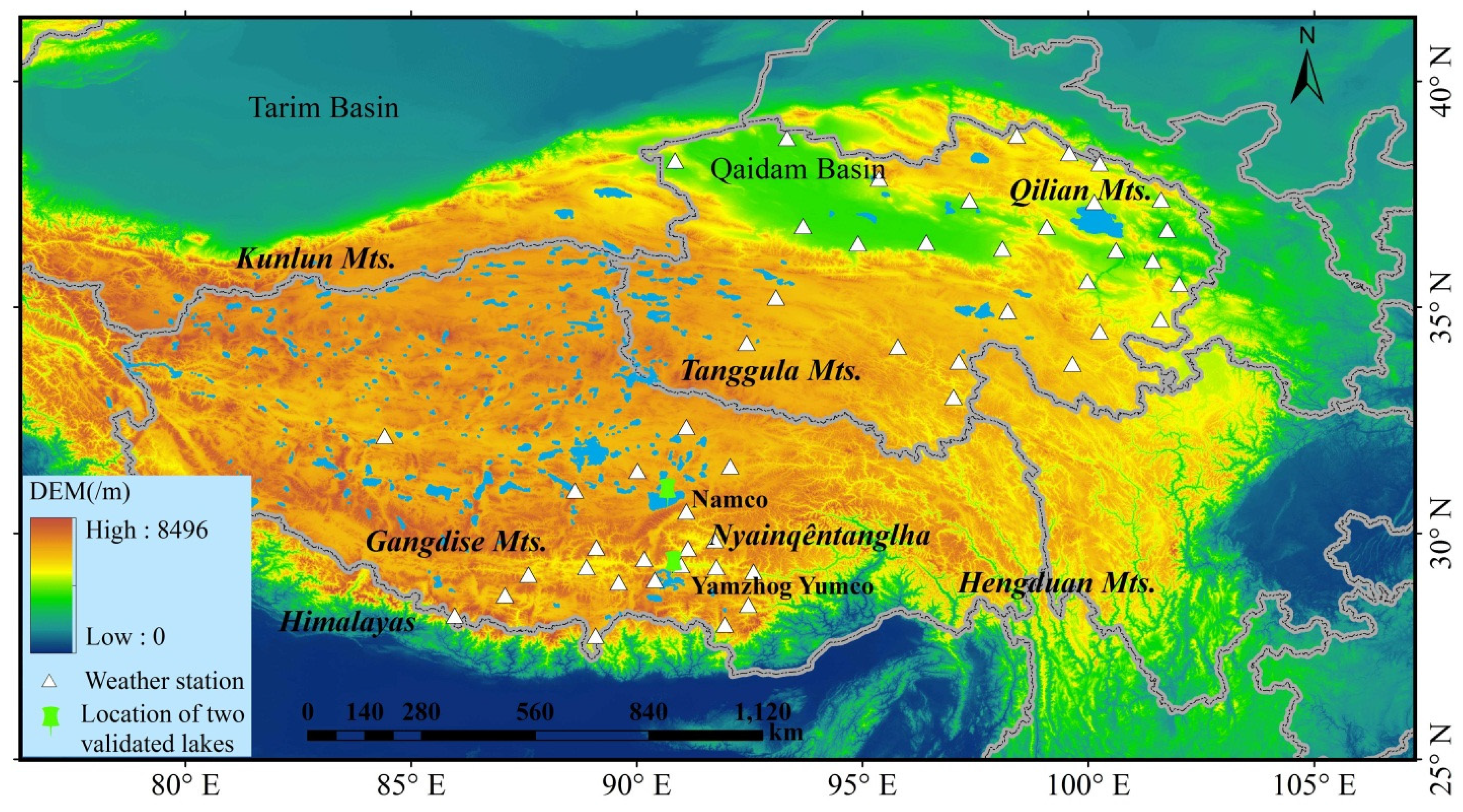
2.2. CryoSat-2 Altimetry Data
2.3. ICESat Altimetry Data
2.4. In Situ Lake Level Observations and Other Materials
| Station ID | Name | Elevation (m) | Latitude (°) | Longitude (°) | T (°C) | P (mm) | ||
|---|---|---|---|---|---|---|---|---|
| Mean | Std. | Mean | Std. | |||||
| South Tibet | ||||||||
| 55773 | Pali | 4302.0 | 27.7333 | 89.0833 | 0.5 | 0.6 | 448.2 | 55.3 |
| 55690 | Cuona | 4280.3 | 27.9833 | 91.9500 | 0.3 | 0.6 | 425.1 | 58.7 |
| 55655 | Nielaer | 3810.0 | 28.1833 | 85.9667 | 4.0 | 0.6 | 601.8 | 113.4 |
| 55696 | Longzi | 3860.0 | 28.4167 | 92.4667 | 5.7 | 0.4 | 299.7 | 64.0 |
| 55664 | Dingri | 4300.0 | 28.6333 | 87.0833 | 3.5 | 0.5 | 302.9 | 77.5 |
| 55680 | Jiangzi | 4040.0 | 28.9167 | 89.6000 | 5.4 | 0.5 | 280.9 | 59.9 |
| 55681 | Langkazi | 4432.4 | 28.9667 | 90.4000 | 3.4 | 0.6 | 381.6 | 80.9 |
| 55569 | Lazi | 4000.0 | 29.0833 | 87.6000 | 7.3 | 0.5 | 353.7 | 93.0 |
| 56307 | Jiacha | 3260.0 | 29.1500 | 92.5833 | 9.6 | 0.5 | 530.1 | 118.8 |
| 55578 | Shigatse | 3836.0 | 29.2500 | 88.8833 | 7.0 | 0.5 | 440.9 | 111.4 |
| 55598 | Zedang | 3551.7 | 29.2500 | 91.7667 | 9.4 | 0.7 | 401.9 | 97.9 |
| 55589 | Gongga | 3555.3 | 29.3000 | 90.9833 | 8.9 | 0.5 | 416.5 | 114.9 |
| 55585 | Nimu | 3809.4 | 29.4333 | 90.1667 | 7.4 | 0.5 | 358.0 | 82.9 |
| 55591 | Lhasa | 3648.9 | 29.6667 | 91.1333 | 8.9 | 0.7 | 463.3 | 90.7 |
| 55572 | Nanmulin | 4000.0 | 29.6833 | 89.1000 | 6.2 | 0.4 | 480.3 | 129.7 |
| 55593 | Mozhugongka | 3804.3 | 29.8500 | 91.7333 | 6.5 | 0.7 | 571.4 | 116.4 |
| 55437 | Pulan | 3900.0 | 30.2833 | 81.2500 | 3.9 | 0.7 | 147.3 | 46.5 |
| Southern Changtang | ||||||||
| 55493 | Damxung | 4200.0 | 30.4833 | 91.1000 | 2.3 | 0.7 | 489.2 | 105.0 |
| 55472 | Xainza | 4672.0 | 30.9500 | 88.6333 | 0.5 | 0.6 | 346.6 | 76.5 |
| 55279 | Bange | 4700.0 | 31.3833 | 90.0167 | −0.1 | 0.7 | 340.2 | 73.8 |
| 55299 | Nagqu | 4507.0 | 31.4833 | 92.0667 | −0.3 | 0.7 | 455.4 | 83.1 |
| 55248 | Gaize | 4414.9 | 32.1500 | 84.4167 | 0.8 | 0.8 | 187.7 | 41.7 |
| 55294 | Anduo | 4800.0 | 32.3500 | 91.1000 | −2.2 | 0.8 | 470.9 | 65.4 |
| northeastern TP | ||||||||
| 56029 | Yushu | 3681.2 | 33.0167 | 97.0167 | 3.9 | 0.7 | 480.2 | 68.4 |
| 56046 | Dari | 3967.5 | 33.7500 | 99.6500 | −0.3 | 0.7 | 562.0 | 61.2 |
| 56034 | Qingshuihe | 4415.4 | 33.8000 | 97.1333 | −4.0 | 0.9 | 518.2 | 70.2 |
| 56021 | Qulaima | 4175.0 | 34.1333 | 95.7833 | −1.4 | 0.7 | 429.1 | 73.2 |
| 56043 | Guoluo | 3719.0 | 34.4667 | 100.2500 | 0.1 | 0.6 | 515.6 | 72.7 |
| 56065 | Henan | 3500.0 | 34.7333 | 101.6000 | 0.0 | 0.6 | 561.7 | 90.7 |
| 56033 | Maduo | 4272.3 | 34.9167 | 98.2167 | −3.0 | 0.7 | 342.3 | 51.5 |
| 52974 | Tongren | 2491.4 | 35.5167 | 102.0167 | 6.5 | 0.6 | 402.8 | 65.2 |
| 52943 | Xinghai | 3323.2 | 35.5833 | 99.9833 | 1.9 | 0.4 | 374.5 | 70.8 |
| 52868 | Guizhou | 2237.1 | 36.0333 | 101.4333 | 7.8 | 0.5 | 251.1 | 50.7 |
| 52856 | Qiaboqia | 2835.0 | 36.2667 | 100.6167 | 4.9 | 0.6 | 315.6 | 40.4 |
| 52836 | Dulan | 3189.0 | 36.3000 | 98.1000 | 3.7 | 0.5 | 222.8 | 57.7 |
| 52818 | Golmud | 2807.6 | 36.4167 | 94.9000 | 6.1 | 0.6 | 44.6 | 16.6 |
| 52825 | Nomhon | 2790.4 | 36.4333 | 96.4167 | 5.6 | 0.5 | 51.3 | 25.9 |
| 52866 | Xining | 2295.2 | 36.7167 | 101.7500 | 6.0 | 0.5 | 413.1 | 60.3 |
| 52754 | Gangcha | 3301.5 | 37.3333 | 100.1333 | 0.3 | 0.5 | 383.3 | 41.3 |
| 52737 | Delingha | 2981.5 | 37.3667 | 97.3667 | 4.7 | 0.5 | 205.4 | 58.9 |
| 52765 | Menyuan | 2850.0 | 37.3833 | 101.6167 | 1.5 | 0.5 | 511.4 | 60.6 |
| 52713 | Da Qaidam | 3173.2 | 37.8500 | 95.3667 | 2.8 | 0.7 | 94.0 | 35.2 |
| 52657 | Qilian | 2787.4 | 38.1833 | 100.2500 | 1.7 | 0.5 | 413.7 | 62.6 |
| 52645 | Yeniugou | 3320.0 | 38.4167 | 99.5833 | −2.4 | 0.6 | 428.1 | 81.8 |
| 52633 | Tuole | 3367.0 | 38.8000 | 98.4167 | −1.9 | 0.5 | 311.4 | 59.6 |
| Northern Changtang (Hol Xil) | ||||||||
| 56004 | Tuotuohe | 4533.1 | 34.2167 | 92.4333 | −3.3 | 0.8 | 305.7 | 74.5 |
| 52908 | Wudaoliang | 4612.2 | 35.2167 | 93.0833 | −4.7 | 0.6 | 325.3 | 57.9 |
| 51886 | Mangya | 2944.8 | 38.2500 | 90.8500 | 4.1 | 0.5 | 48.6 | 23.5 |
| 52707 | Xiaozaohuo | 2767.0 | 36.8000 | 93.6833 | 4.7 | 0.6 | 31.4 | 13.1 |
| 52602 | Lenghu | 2770.0 | 38.7500 | 93.3333 | 3.3 | 0.5 | 17.6 | 8.8 |
2.5. Height Reference System Conversion of Satellite Altimetry, Data Processing and Estimation of Lake Level Trends
3. Results and Analysis
3.1. Evaluation of Cryosat-2 Altimetry Data on the Two Typical Lakes
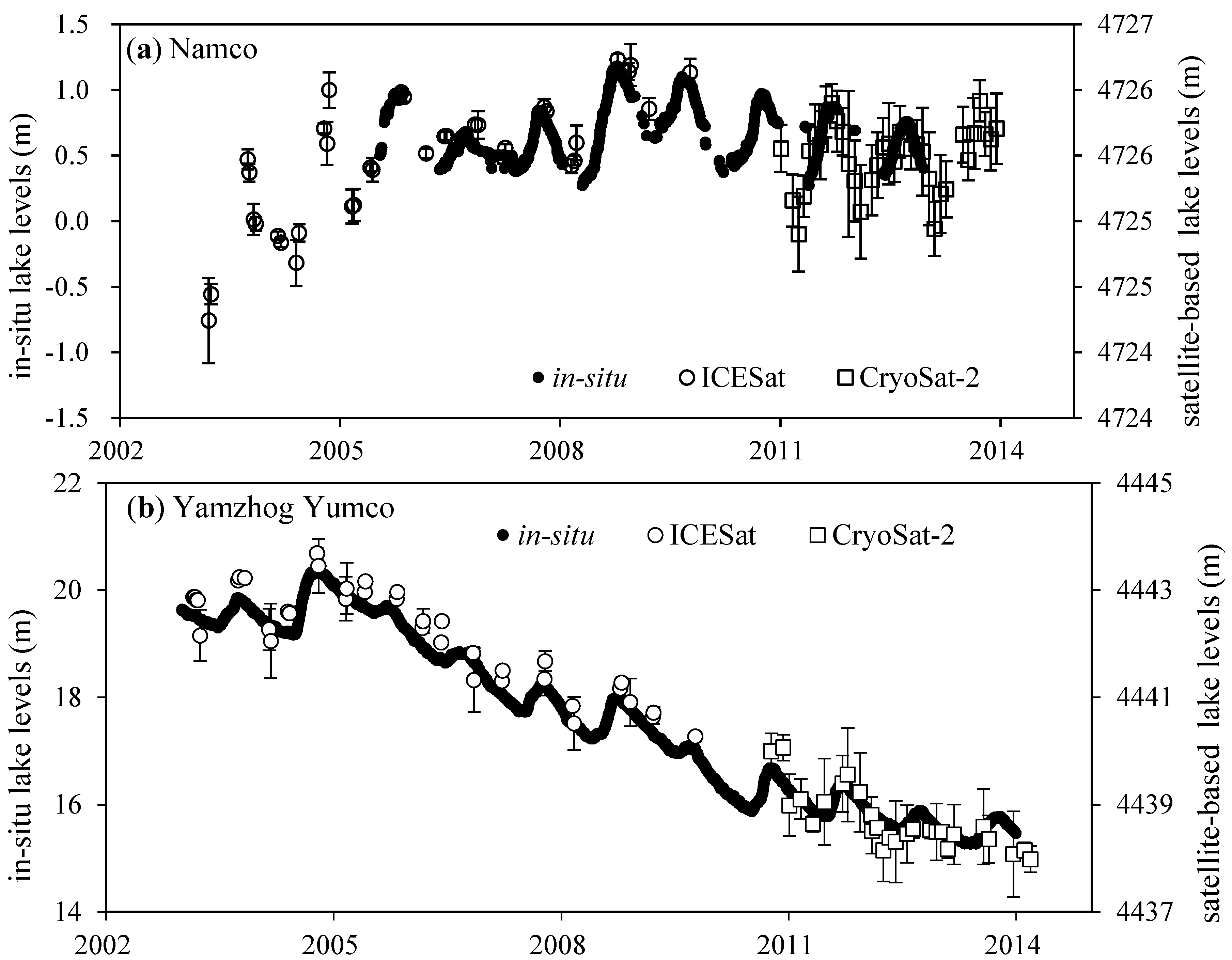
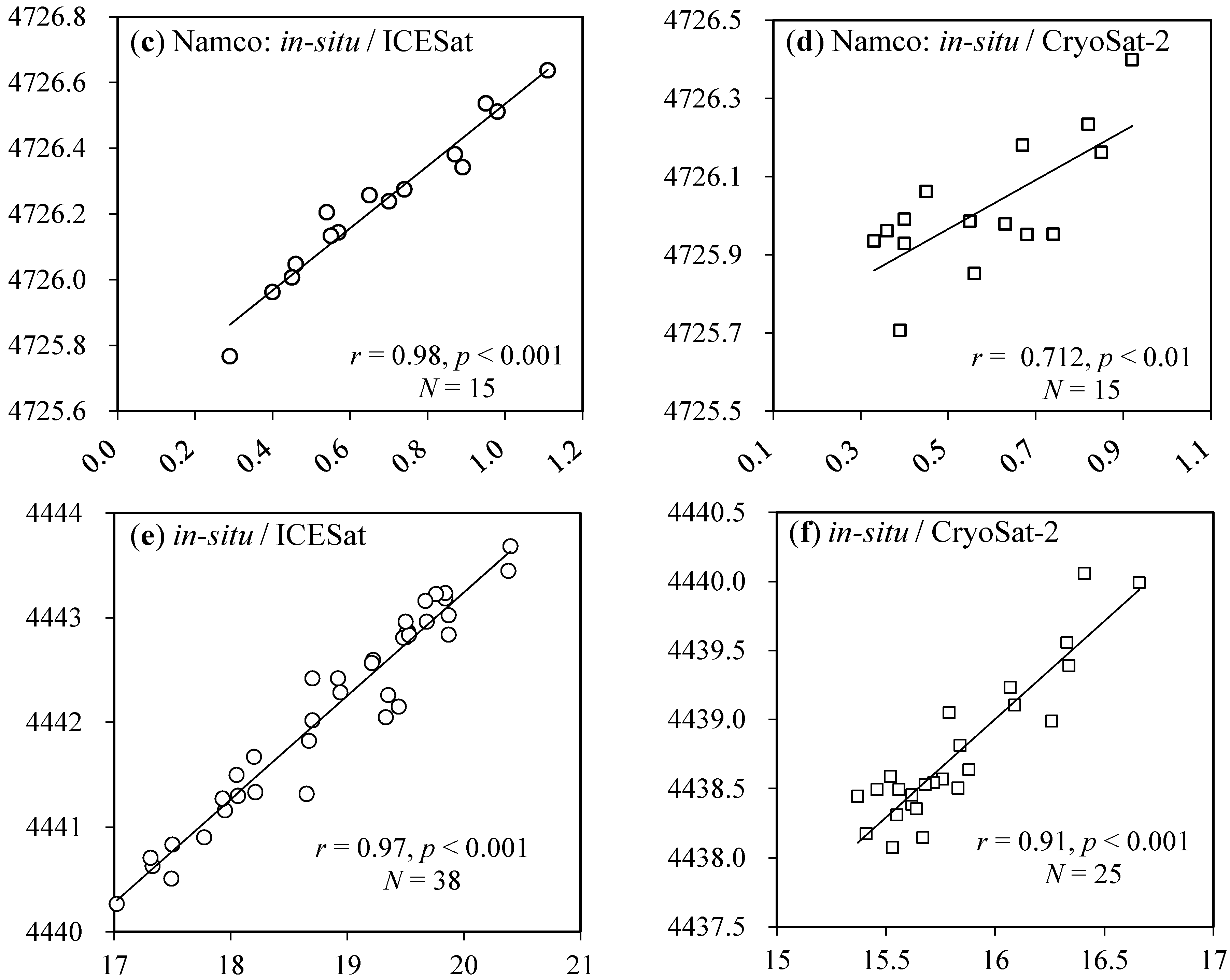
3.2. Water Level Changes of Tibetan Lakes Based on Combined Satellite Altimetry Measurements
| Sub-Zones | Climate Type | Area (km2) | Area-Averaged Lake Level Change Rates (m·year−1) | ||
|---|---|---|---|---|---|
| 2003–2009 | 2010–2014 | 2003–2014 | |||
| R1-South Tibet | temperate and semi-arid | 1775.16 | −0.19 ± 0.01 | −0.18 ± 0.03 | −0.25 ± 0.01 |
| R2-Southern Changtang | subarctic and semi-arid | 11812.17 | 0.28 ± 0.03 | 0.18 ± 0.02 | 0.19 ± 0.01 |
| R3-Northern Changtang | subarctic and arid | 2368.56 | 0.32 ± 0.01 | 0.48 ± 0.08 | 0.34 ± 0.01 |
| R4-western TP | temperate and arid | 586.76 | 0.13 ± 0.01 | 0.02 ± 0.02 | 0.02 ± 0.02 |
| R5-Northern Kunlun | temperate and arid | 1028.86 | 0.23 ± 0.01 | 0.56 ± 0.02 | 0.33 ± 0.01 |
| R6-Central Qinghai | subarctic and semi-humid | 830.81 | 0.19 ± 0.01 | 0.08 ± 0.04 | 0.05 ± 0.01 |
| R7-Qaidam Basin | temperate and arid | 312.81 | 0.03 ± 0.03 | 0.04 ± 0.15 | 0.03 ± 0.02 |
| R8-northeastern TP | temperate and semi-arid | 5247.79 | 0.13 ± 0.00 | 0.19 ± 0.02 | 0.14 ± 0.00 |
| Total area (TP lakes) | 23962.91 | 0.21 ± 0.02 | 0.19 ± 0.03 | 0.16 ± 0.01 | |
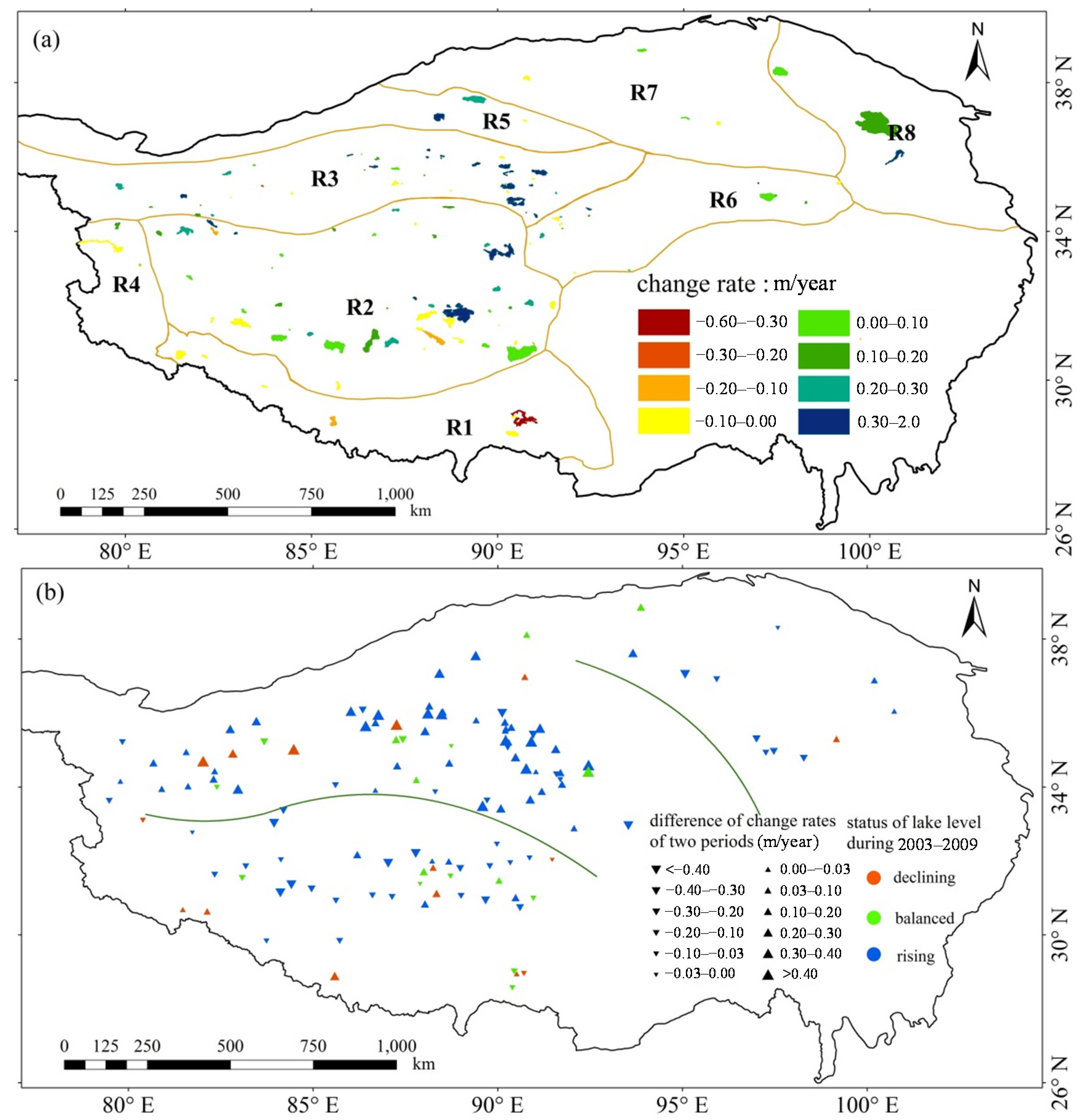
4. Discussion on the Potential Cause of Regional Lake Change Patterns
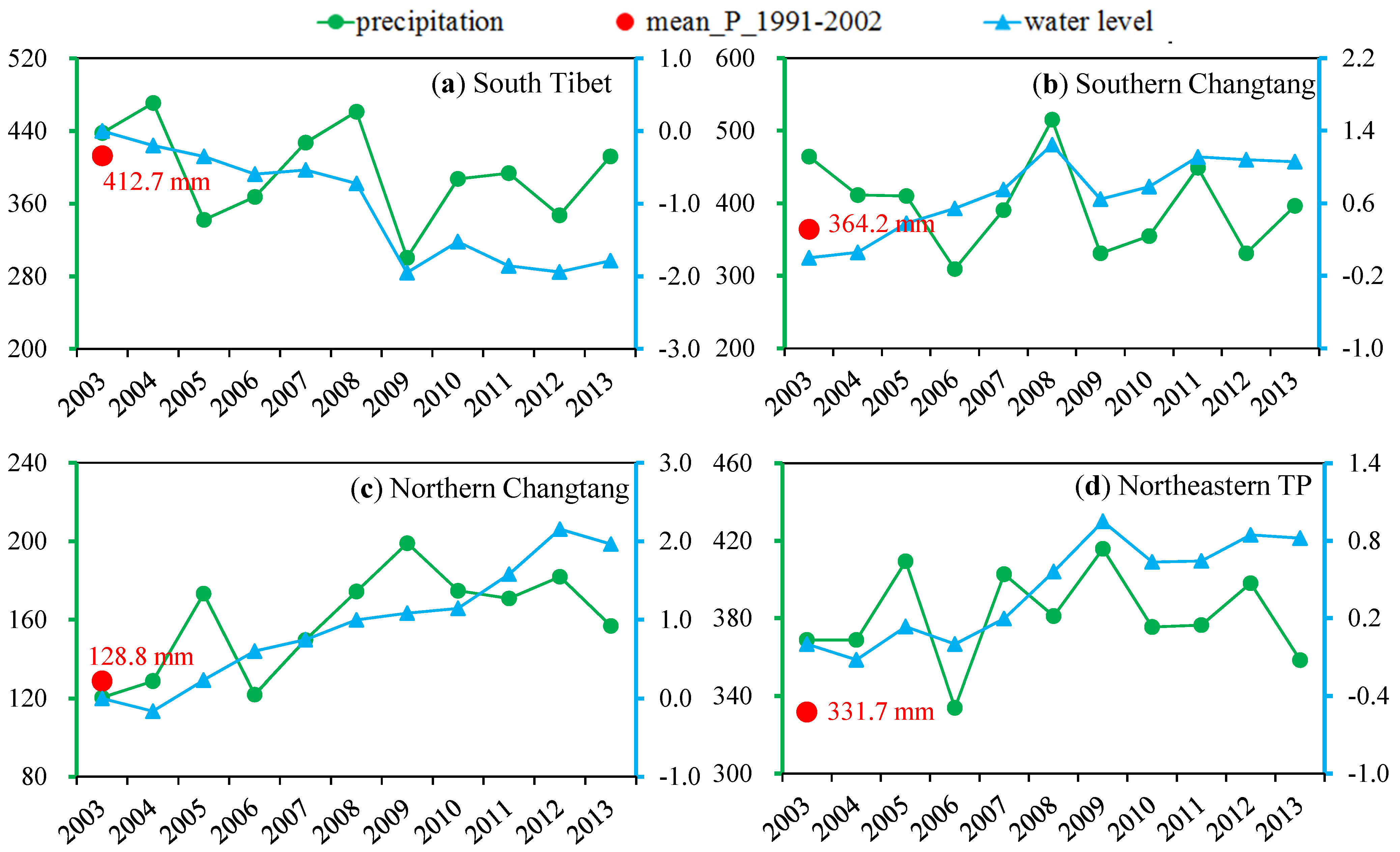
5. Conclusions
Acknowledgments
Author Contributions
Conflicts of Interest
References
- Phan, V.H.; Lindenbergh, R.; Menenti, M. Icesat derived elevation changes of tibetan lakes between 2003 and 2009. Int. J. Appl. Earth Obs. 2012, 17, 12–22. [Google Scholar] [CrossRef]
- Song, C.; Huang, B.; Ke, L. Modeling and analysis of lake water storage changes on the tibetan plateau using multi-mission satellite data. Remote Sens. Environ. 2013, 135, 25–35. [Google Scholar] [CrossRef]
- Song, C.; Huang, B.; Richards, K.; Ke, L.; Hien Phan, V. Accelerated lake expansion on the tibetan plateau in the 2000s: Induced by glacial melting or other processes? Water Resour. Res. 2014, 50, 3170–3186. [Google Scholar] [CrossRef]
- Zhang, G.; Yao, T.; Xie, H.; Kang, S.; Lei, Y. Increased mass over the tibetan plateau: From lakes or glaciers? Geophys. Res. Lett. 2013, 40, 2025–2130. [Google Scholar] [CrossRef]
- Jacob, T.; Wahr, J.; Pfeffer, W.T.; Swenson, S. Recent contributions of glaciers and ice caps to sea level rise. Nature 2012, 482, 514–518. [Google Scholar] [CrossRef] [PubMed]
- Lei, Y.; Yang, K.; Wang, B.; Sheng, Y.; Bird, B.W.; Zhang, G.; Tian, L. Response of inland lake dynamics over the tibetan plateau to climate change. Clim. Chang. 2014, 125, 281–290. [Google Scholar] [CrossRef]
- Song, C.; Huang, B.; Ke, L.; Richards, K.S. Seasonal and abrupt changes in the water level of closed lakes on the tibetan plateau and implications for climate impacts. J. Hydrol. 2014, 514, 131–144. [Google Scholar] [CrossRef]
- Yang, K.; Wu, H.; Qin, J.; Lin, C.; Tang, W.; Chen, Y. Recent climate changes over the tibetan plateau and their impacts on energy and water cycle: A review. Glob. Planet Chang. 2014, 112, 79–91. [Google Scholar] [CrossRef]
- Wang, X.; Gong, P.; Zhao, Y.; Xu, Y.; Cheng, X.; Niu, Z.; Luo, Z.; Huang, H.; Sun, F.; Li, X. Water-level changes in China’s large lakes determined from icesat/glas data. Remote Sens. Environ. 2013, 132, 131–144. [Google Scholar] [CrossRef]
- Schutz, B.; Zwally, H.; Shuman, C.; Hancock, D.; di Marzio, J. Overview of the icesat mission. Geophys. Res. Lett. 2005, 32. [Google Scholar] [CrossRef]
- Calmant, S.; Seyler, F.; Cretaux, J.F. Monitoring continental surface waters by satellite altimetry. Surv. Geophys. 2008, 29, 247–269. [Google Scholar] [CrossRef]
- Crétaux, J.F.; Birkett, C. Lake studies from satellite radar altimetry. C. R. Geosci. 2006, 338, 1098–1112. [Google Scholar] [CrossRef]
- Kropáček, J.; Braun, A.; Kang, S.; Feng, C.; Ye, Q.; Hochschild, V. Analysis of lake level changes in nam co in central tibet utilizing synergistic satellite altimetry and optical imagery. Int. J. Appl. Earth Obs. 2012, 17, 3–11. [Google Scholar] [CrossRef]
- Hwang, C.; Peng, M.F.; Ning, J.; Luo, J.; Sui, C.H. Lake level variations in china from topex/poseidon altimetry: Data quality assessment and links to precipitation and enso. Geophys. J. Int. 2005, 161, 1–11. [Google Scholar] [CrossRef]
- Kleinherenbrink, M.; Ditmar, P.; Lindenbergh, R. Retracking cryosat data in the sarin mode and robust lake level extraction. Remote Sens. Environ. 2014, 152, 38–50. [Google Scholar] [CrossRef]
- Xu, Z.; Gong, T.; Li, J. Decadal trend of climate in the tibetan plateau—Regional temperature and precipitation. Hydrol. Process. 2008, 22, 3056–3065. [Google Scholar] [CrossRef]
- Meng, Y.; Liu, G.; Li, M. Tracing the sources and processes of groundwater in an alpine glacierized region in southwest china: Evidence from environmental isotopes. Water 2015, 7, 2673–2690. [Google Scholar] [CrossRef]
- Yao, T.; Thompson, L.; Yang, W.; Yu, W.; Gao, Y.; Guo, X.; Yang, X.; Duan, K.; Zhao, H.; Xu, B. Different glacier status with atmospheric circulations in tibetan plateau and surroundings. Nat. Clim. Chang. 2012, 2, 663–667. [Google Scholar] [CrossRef]
- Wingham, D.; Francis, C.; Baker, S.; Bouzinac, C.; Brockley, D.; Cullen, R.; de Chateau-Thierry, P.; Laxon, S.; Mallow, U.; Mavrocordatos, C. Cryosat: A mission to determine the fluctuations in earth’s land and marine ice fields. Adv. Space Res. 2006, 37, 841–871. [Google Scholar] [CrossRef]
- Labroue, S.; Boy, F.; Picot, N.; Urvoy, M.; Ablain, M. First quality assessment of the cryosat-2 altimetric system over ocean. Adv. Space Res. 2012, 50, 1030–1045. [Google Scholar] [CrossRef]
- Zhang, G.; Xie, H.; Kang, S.; Yi, D.; Ackley, S.F. Monitoring lake level changes on the tibetan plateau using icesat altimetry data (2003–2009). Remote Sens. Environ. 2011, 115, 1733–1742. [Google Scholar] [CrossRef]
- Wang, X.; Cheng, X.; Gong, P.; Huang, H.; Li, Z.; Li, X. Earth science applications of icesat/glas: A review. Int. J. Remote Sens. 2011, 32, 8837–8864. [Google Scholar] [CrossRef]
- Ji, L.; Geng, X.; Sun, K.; Zhao, Y.; Gong, P. Target detection method for water mapping using landsat 8 oli/tirs imagery. Water 2015, 7, 794–817. [Google Scholar] [CrossRef]
- Kääb, A.; Berthier, E.; Nuth, C.; Gardelle, J.; Arnaud, Y. Contrasting patterns of early twenty-first-century glacier mass change in the himalayas. Nature 2012, 488, 495–498. [Google Scholar] [CrossRef]
- Siegfried, M.R.; Fricker, H.A.; Roberts, M.; Scambos, T.A.; Tulaczyk, S. A decade of west antarctic subglacial lake interactions from combined icesat and cryosat-2 altimetry. Geophys. Res. Lett. 2014, 41, 891–898. [Google Scholar] [CrossRef]
- McMillan, M.; Corr, H.; Shepherd, A.; Ridout, A.; Laxon, S.; Cullen, R. Three-dimensional mapping by cryosat-2 of subglacial lake volume changes. Geophys. Res. Lett. 2013, 40, 4321–4327. [Google Scholar] [CrossRef]
- Absolute Calibration of Radar Altimeter over Lakes. Available online: http://meetings.copernicus.org/www.cosis.net/abstracts/EGU2007/07620/EGU2007-J-07620.pdf (accessed on 24 August 2015).
- Zheng, J.; Yin, Y.; Li, B. A new scheme for climate regionalization in china. Acta Geogr. Sin. 2010, 65, 3–12. (In Chinese) [Google Scholar]
- Ye, Q.; Zhu, L.; Zheng, H.; Naruse, R.; Zhang, X.; Kang, S. Glacier and lake variations in the yamzhog yumco basin, southern tibetan plateau, from 1980 to 2000 using remote-sensing and gis technologies. J. Glaciol. 2007, 53, 673–676. [Google Scholar] [CrossRef]
- Huang, L.; Liu, J.; Shao, Q.; Liu, R. Changing inland lakes responding to climate warming in northeastern tibetan plateau. Clim. Chang. 2011, 109, 479–502. [Google Scholar] [CrossRef]
- Lei, Y.; Yao, T.; Bird, B.W.; Yang, K.; Zhai, J.; Sheng, Y. Coherent lake growth on the central tibetan plateau since the 1970s: Characterization and attribution. J. Hydrol. 2013, 483, 61–67. [Google Scholar] [CrossRef]
- Liao, J.; Shen, G.; Li, Y. Lake variations in response to climate change in the tibetan plateau in the past 40 years. Int. J. Digit. Earth 2013, 6, 534–549. [Google Scholar] [CrossRef]
- Wu, Y.; Zheng, H.; Zhang, B.; Lei, L. Long-term changes of lake level and water budget in the nam co lake basin, central tibetan plateau. J. Hydrometeorol. 2014, 15, 1312–1322. [Google Scholar] [CrossRef]
- Ke, L.; Ding, X.; Song, C. Estimation of mass balance of dongkemadi glaciers with multiple methods based on multi-mission satellite data. Quat. Int. 2015, 371, 58–66. [Google Scholar] [CrossRef]
- Phan, V.H.; Lindenbergh, R.; Menenti, M. Geometric dependency of tibetan lakes on glacial runoff. HESSD 2013, 10, 729–768. [Google Scholar]
- Wan, W.; Xiao, P.; Feng, X.; Li, H.; Ma, R.; Duan, H.; Zhao, L. Monitoring lake changes of qinghai-tibetan plateau over the past 30 years using satellite remote sensing data. Chin. Sci. Bull. 2014, 59, 1021–1035. [Google Scholar] [CrossRef]
- Li, J.; Sheng, Y.; Luo, J.; Shen, Z. Remotely sensed mapping of inland lake area changes in the tibetan plateau. J. Lake Sci. 2011, 23, 311–320. [Google Scholar]
- Song, C.; Ye, Q.; Cheng, X. Shifts in water-level variation of Namco in the central Tibetan Plateau from ICESat and CryoSat-2 altimetry and station observations. Sci. Bull. 2015, 60, 1287–1297. [Google Scholar] [CrossRef]
- Ke, L.; Ding, X.; Song, C. Heterogeneous changes of glaciers over the western Kunlun Mountains based on ICESat and Landsat-8 derived glacier inventory. Remote Sens Environ. 2015, 168, 13–23. [Google Scholar] [CrossRef]
© 2015 by the authors; licensee MDPI, Basel, Switzerland. This article is an open access article distributed under the terms and conditions of the Creative Commons Attribution license (http://creativecommons.org/licenses/by/4.0/).
Share and Cite
Song, C.; Ye, Q.; Sheng, Y.; Gong, T. Combined ICESat and CryoSat-2 Altimetry for Accessing Water Level Dynamics of Tibetan Lakes over 2003–2014. Water 2015, 7, 4685-4700. https://doi.org/10.3390/w7094685
Song C, Ye Q, Sheng Y, Gong T. Combined ICESat and CryoSat-2 Altimetry for Accessing Water Level Dynamics of Tibetan Lakes over 2003–2014. Water. 2015; 7(9):4685-4700. https://doi.org/10.3390/w7094685
Chicago/Turabian StyleSong, Chunqiao, Qinghua Ye, Yongwei Sheng, and Tongliang Gong. 2015. "Combined ICESat and CryoSat-2 Altimetry for Accessing Water Level Dynamics of Tibetan Lakes over 2003–2014" Water 7, no. 9: 4685-4700. https://doi.org/10.3390/w7094685
APA StyleSong, C., Ye, Q., Sheng, Y., & Gong, T. (2015). Combined ICESat and CryoSat-2 Altimetry for Accessing Water Level Dynamics of Tibetan Lakes over 2003–2014. Water, 7(9), 4685-4700. https://doi.org/10.3390/w7094685






